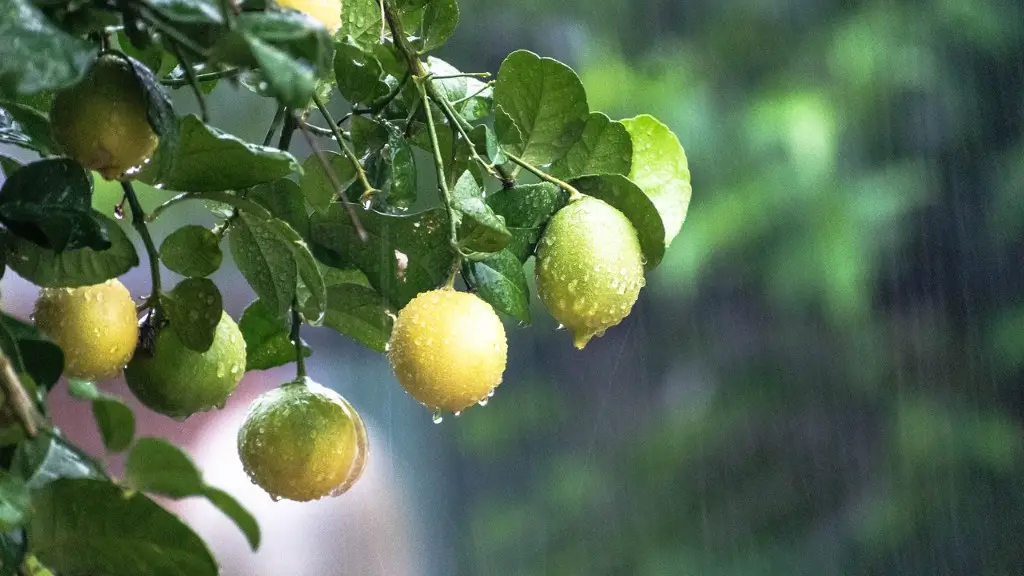Avocado trees are quickly becoming popular plants to keep indoors. On the surface, this seems like an impossible task, as the fruit requires a lot of sun and warm temperatures to mature. But with the right care, an avocado tree can easily be grown indoors.
The first step to growing an avocado tree indoors is preparing the seed. With the correct care, this process is simple and straightforward. According to Lisa Allen, a horticulturist from University of California Master Gardeners Program, “Start with a healthy avocado seed that has been washed thoroughly. Remove it from the fruit, put it on a plate, and cover with a wet cloth. Leave the seed out for one to two days or until it splits or has a crack.”
Once the seed has cracked, it is ready for planting. Fill a pot with 6-8 inches of soil and place the seed in the center. Ensure that the pointed tip of the seed is facing up and the flat side is tucked inside the soil. The seed should be covered with 2/3 inches of soil. The pot should be placed in a warm and sunny area for the best growth.
It is important to remember that an avocado tree grown indoors is not going to produce the same amount of fruit as one grown outdoors. Allen states “An avocado tree grown inside will produce smaller fruit with less flavor and vitamins than the fruit grown outdoors. The avocado tree will only flower if there is enough light present.”
The avocado tree needs regular maintenance to thrive. Ensure that the soil is lightly moist with a little fertilizer every two weeks. Allow the tree to breathe and rotate the pot regularly allowing it to obtain equal amounts of sunlight. The tree should also be pruned regularly to maintain size and keep it in line with the pot.
Overall, growing an avocado tree indoors is not impossible. With the correct care, an avocado enthusiast can create a beautiful little tree that will bring their living space to life.
Nutrition for an Avocado Tree
Good nutrition is key for a healthy avocado tree. Fertilizing a tree grown indoors is essential for promoting growth and protecting the plant from various diseases. Small batches of significant-release fertilizer each month will keep the tree in good shape. It is important to ensure that the tree is not over fertilized as this can lead to problems.
A good fertilizer will include nitrogen, phosphorous, and potassium. Nitrogen will help with root and top growth while phosphorous encourages deep roots that can penetrate the soil. Lastly, potassium is used to fight diseases and produce strong fruit.
For mature trees, it is important to prune the excess foliage. Pruning is a great way to direct the tree’s energy toward growing new branches and leaves. This will not only help with keeping the tree healthy but also help to maintain a nice size.
Light and Water Requirements
In order for an avocado tree to grow effectively indoors, there are certain light and water requirements that must be met. The tree should be placed near a window or balcony with an adequate amount of natural light for several hours a day. This can have a significant effect on the growth and health of the tree.
Watering is also important for a healthy avocado tree. The soil should be kept lightly moist, but not overly wet as this can lead to root rot. A potting soil created specifically for houseplants can help with maintaining the correct water levels. Depending on the size of the pot, it may require more or less water, so regular monitoring is important.
Combatting Pests and Diseases
Pests and diseases can infect an avocado tree, ruining its health and the taste of the fruit. Common pests include beetles and caterpillars, which can be easily controlled by regular water sprays and pesticide sprays. Diseases such as root rot and anthracnose can also affect an avocado tree if the soil is overly wet or if the fertilizer is overused.
Avocado trees are prone to certain fungal or bacterial infections due to a high degree of air moisture. The tree should be regularly inspected for any signs of diseases or pests. If any issues appear, it is best to consult a horticulturist for advice on the best treatment.
Harvesting the Fruit
Harvesting the fruit from an avocado tree can be a long process and requires patience and knowledge. The fruit typically takes around six to nine months to mature, but this time frame can vary depending on the type of avocado tree. The first harvest usually happens four to five years after planting and the subsequent harvest two to three years later.
When harvesting the avocados, the fruit needs to be lightly touched and squeezed. If it gives slightly, the fruit is ripe and ready to be picked. However, if the fruit is too soft, it has most likely gone past its prime. The picked avocados should be ripened immediately, either on the tree or at room temperature.
Health Benefits of Eating Avocados
Avocados are packed with various nutrients, vitamins and minerals. A 100 gram serving of avocado is a great source of dietary fiber, vitamin C and K as well as vitamin B6 and E. They are also high in healthy fats, making them a great option for those looking to include more healthy fats into their diet.
These same healthy fats and vitamins will also help keep skin healthy and hydrated. Avocados are also a great source of antioxidants, protecting the body from free radicals, the signs of premature aging, and helping the body to fight off infection.
Health Risks with Eating Avocados
Avocados are chock full of nutrients and have many health benefits, however, it is important to remember that some health risks can occur from overindulging. Excess consumption of avocados can result in weight gain and issues with digestion. Eating too many can lead to an increased risk of developing high cholesterol and heart disease.
Avocado enthusiasts should remember that everything should be done in moderation. By following a healthy, balanced diet and avoiding overindulgence, an avocado enthusiast can enjoy all the benefits the fruit has to offer without any of the risks.



